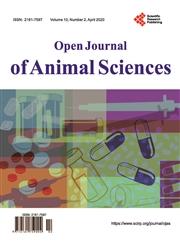Filamentous Green Algae Reduce Walleye Fingerling Production in Earthen-Substrate Ponds
引用次数: 1
Abstract
Reduced walleye (Sander vitreus) fingerling production possibly related to nuisance filamentous green algae and overly stable water chemistry patterns is a concern in earthen-substrate ponds at Blue Dog State Fish Hatchery, South Dakota, USA. We describe the success of alfalfa (Medicago sativa) meal (AFM, n = 2), alfalfa meal plus soybean (Glycine max) meal (AFM + SBM, n = 1), and alfalfa meal plus liquid 28N:0P:0K (AFM + 28:0:0, n = 1) at achieving walleye production objectives (>104,000 walleye and 32 kilograms/hectare) as well as the occurrence of filamentous green algae and the associated patterns of ammonia-nitrogen, pH, and dissolved oxygen in earthen-substrate ponds. Walleye production objectives were only achieved when filamentous green algae were absent preceding harvest, which occurred in one pond that received AFM and in the pond that received AFM + 28:0:0. The presence of filamentous green algae preceding harvest was associated with higher dissolved oxygen and pH, whereas declines in these variables occurred when filamentous green algae were absent. Organic fertilizer alone exhibited low ammonia-nitrogen (<0.1 mg/L) despite the substitution of higher protein content soybean meal, but supplementation with 28:0:0 increased ammonia-nitrogen to 0.23 mg/L. These findings highlight the reduction in walleye fingerling production that occurred in the presence of filamentous green algae and the unpredictability of results when two earthen-substrate ponds are treated exactly the same with alfalfa meal. Achievement of walleye production objectives, lack of nuisance filamentous green algae, and promotion of favorable patterns in water chemistry warrant future experimentation with alfalfa meal supplemented with 28:0:0 in earthen-substrate ponds at this hatchery.丝状绿藻减少了土基质池塘中孔雀鱼的产量
在美国南达科他州蓝狗州立养鱼场的土壤基质池塘中,可能与讨厌的丝状绿藻和过于稳定的水化学模式有关的walleye(Sander vitreus)鱼种产量减少是一个令人担忧的问题。我们描述了苜蓿粉(Medicago sativa)(AFM,n=2)、苜蓿粉加大豆粉(Glycine max)(AFM+SBM,n=1)的成功,苜蓿粉加液体28N:0P:0K(AFM+28::0,n=1),以实现大眼虫的生产目标(>104000只大眼虫和32公斤/公顷),以及丝状绿藻的出现以及土壤基质池塘中氨氮、pH值和溶解氧的相关模式。Walleye的生产目标只有在收获前没有丝状绿藻的情况下才能实现,这发生在一个接受AFM的池塘和接受AFM+28::0的池塘中。收获前丝状绿藻的存在与较高的溶解氧和pH有关,而当没有丝状绿藻时,这些变量会下降。尽管取代了蛋白质含量较高的豆粕,但有机肥单独表现出低氨氮(<0.1mg/L),但补充28:0:0可将氨氮提高到0.23mg/L。这些发现突显了在丝状绿藻存在的情况下,walleye鱼种产量的减少,以及当用苜蓿粉完全相同地处理两个土底塘时,结果的不可预测性。实现walleye的生产目标,减少令人讨厌的丝状绿藻,以及促进水化学的有利模式,保证了未来在该孵化场的土底池中用添加了28:0:0的苜蓿粉进行实验。
本文章由计算机程序翻译,如有差异,请以英文原文为准。
求助全文
约1分钟内获得全文
求助全文

 求助内容:
求助内容: 应助结果提醒方式:
应助结果提醒方式:


